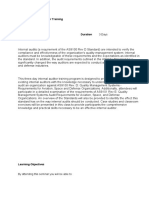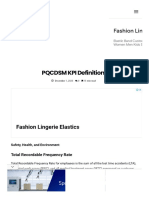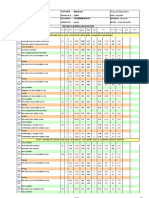Ashok Leyland IAQ Quality Sustainability Award Summary
Ashok Leyland IAQ Quality Sustainability Award Summary
Uploaded by
SudhagarCopyright:
Available Formats
Ashok Leyland IAQ Quality Sustainability Award Summary
Ashok Leyland IAQ Quality Sustainability Award Summary
Uploaded by
SudhagarCopyright
Available Formats
Share this document
Did you find this document useful?
Is this content inappropriate?
Copyright:
Available Formats
Ashok Leyland IAQ Quality Sustainability Award Summary
Ashok Leyland IAQ Quality Sustainability Award Summary
Uploaded by
SudhagarCopyright:
Available Formats
One Page Summary
Phosphate Sludge Generation Reduction
Name of the Project: Phosphate Sludge (hazardous waste) generation reduction in Cabin pre-treatment line
Name of the Organization hosting the project: Ashok Leyland Ltd. (India)
UN Sustainability Development Goal affected: Goal 12: Responsible Consumption and Production
Introduction:
In Commercial Vehicle manufacturing, painting is one of the important process which generates sludge (hazardous
waste). At Ashok Leyland, we comply with all transportation and disposal rules related to the waste management
standard (prevalent in the country). While adhering to compliances, being a responsible organization, we are
continually innovating to reduce waste generation. One such project at our Hosur-2 plant is explained here.
Essence of the project and Problem statement:
In its regulation, State has given the authorized limit for waste generation which is 300MT/annum for paint sludge
and 24 MT/annum for phosphate sludge. At Hosur plant, Paint sludge generation was well within the authorized
limit whereas, Phosphate sludge generation (Hazardous Waste) was a concern nearing to the authorized limit.
Going forward, there was a risk to cross this limit as production volumes were predicted to be higher by 20% in
FY20. Project has been started with the objective of reducing Mean Phosphate sludge generation from 6.92 g/sq.m
to 4 g/sq.m.
Methodology used: Six Sigma DMAIC
Observation and Analysis :
We performed Measurement system analysis (MSA) for
titration checking method (Phosphate sludge measurement
process) to verify whether the measurement system is
capable. Results suggests that the measurement system is
capable as Gage R&R is 0.66% and No. of distinct categories
(NDC) are 214 i.e. project metric data is accurate & precise.
Nine probable causes are identified for high phosphate
sludge generation. Detailed cause validation reveals that
moisture content present in Phosphate sludge is very high
(61% of sludge weight).
Improve (Finding, Implementing the solutions with
resource used):
1. To address this issue of high moisture content in
Phosphate sludge, drying bed is installed, and drying process
is continued. As a result, Mean Phosphate sludge generation
reduced from 6.92 g/sq.m to 5.22 g/sq.m.
2. Even with improved performance, projected annual Pp = 1.98
sludge generation level will be 26 MT against the Govt. Ppk = 1.83
regulation of 24 MT considering 20% higher production
volumes.
To further reduce sludge generation, we went for an
innovative solution of using less coating weight, which was
possible with usage of a different ‘Pre-treatment Chemical’.
From our research, ‘compact & fine phosphate coating chemical’ was found most suitable for this process. After
implementation, Mean Phosphate sludge generation is reduced to 4 g/sq.m. With this, estimated annual sludge
generation will be 20 MT against the Govt. regulation of 24 MT even for 20% higher production volume.
As part of risk analysis, we checked if there’s any adverse impact on Consequential metric (Phosphate coating
weight). Phosphate coating weight process is stable and capable as Ppk is 1.83.
Results and Effects (few):
Phosphate Sludge generation
1. Mean Phosphate sludge generation reduced from 6.92 g/sq.m to 4 8
g/sq.m 55% Reduction
2. Phosphate coating weight process is stable and capable as Ppk is 1.83. 6 6.9 6.8
g/sq.m
3. Phosphating process time reduced from 90 sec. to 60 sec. Productivity
4 5.2 4
improved by 12%. 4.8
4. DM water requirement reduced from 180 KL to 120 KL per annum.
2
5. Financial benefit of INR 5.25 Million.
Jan'19
Feb'19
Before
FY19Q2
FY19Q3
6. Reduction of carbon footprint because of energy consumption
reduction.
Resources used: Expenditure of INR 0.1 Million for Phosphate sludge
drying bed construction.
Locking & Cloning the Improvements: Operation controls procedures are changed, and training has been given
to all associated members. Detailed case study is shared and communicated to all plants of Ashok Leyland.
Tools used in the project: Variable MSA (GRR study), Pugh matrix, Test of Hypothesis (2 sample t-test), Process
capability studies, Variable Control charts, Risk analysis.
You might also like
- Steam BlowingDocument19 pagesSteam Blowingmvdeole100% (1)
- AS9100 D Internal AuditorDocument5 pagesAS9100 D Internal AuditorSudhagar100% (1)
- Mahabal Manpower PlanningDocument4 pagesMahabal Manpower PlanningNitin KambleNo ratings yet
- APQP Timing Plan - Product - Development Plan - Sheet1Document1 pageAPQP Timing Plan - Product - Development Plan - Sheet1Sarvesh SharmaNo ratings yet
- WPS 10Document2 pagesWPS 10Arab WeldersNo ratings yet
- JD - Design Engineer FinalDocument2 pagesJD - Design Engineer FinalSaurav KumarNo ratings yet
- Development of High Strength Steels For Automobiles: Nippon Steel Technical Report No. 88 July 2003Document6 pagesDevelopment of High Strength Steels For Automobiles: Nippon Steel Technical Report No. 88 July 2003Niken ApriliaNo ratings yet
- Presentation of Tool Room, Ranchi PDFDocument36 pagesPresentation of Tool Room, Ranchi PDFvkshsingh81100% (1)
- Identifying and Removing Process Waste: Defects Overproduction Waiting Non-Utilized Staff TalentDocument2 pagesIdentifying and Removing Process Waste: Defects Overproduction Waiting Non-Utilized Staff TalenthoffspringNo ratings yet
- Sustainability Metrics: Measuring The Transition To A Renewable, Abundant, Just San Diego RegionDocument28 pagesSustainability Metrics: Measuring The Transition To A Renewable, Abundant, Just San Diego RegionWRSCNo ratings yet
- Milling Speed & Feed Calculator - Inch To MetricDocument16 pagesMilling Speed & Feed Calculator - Inch To Metricசரவணகுமார் மாரியப்பன்100% (1)
- ASP-npd-01 (Process For Engg. and Development)Document5 pagesASP-npd-01 (Process For Engg. and Development)akash.vd.1603No ratings yet
- ActivityPlanStrategy SmartPMDocument2 pagesActivityPlanStrategy SmartPMLogicInstitute TrainingBahrainNo ratings yet
- 001-CEN Welding and Allied Processes - CEN TC 121Document17 pages001-CEN Welding and Allied Processes - CEN TC 121Pradip Tapan BanerjeeNo ratings yet
- Automotive SteelsDocument12 pagesAutomotive SteelspratyaygeminiNo ratings yet
- Sample Maintenance FormsDocument6 pagesSample Maintenance FormsWoyen AlilinNo ratings yet
- New Product Development (NPD) and Product Life Cycle (PLC) StrategiesDocument4 pagesNew Product Development (NPD) and Product Life Cycle (PLC) StrategiesKanganFatimaNo ratings yet
- 4.SUPREME TREON APQP/1.APQP 2000x1000x9.9kg/1A.ED-021 APQP DEVELOPMENT PLANDocument10 pages4.SUPREME TREON APQP/1.APQP 2000x1000x9.9kg/1A.ED-021 APQP DEVELOPMENT PLANsandeep kumarNo ratings yet
- m2 200i Plasma Consumables Selection Matrix V0 27022019Document2 pagesm2 200i Plasma Consumables Selection Matrix V0 27022019chandra100% (1)
- Lorenz Shaping-02Document1 pageLorenz Shaping-02Azhar ImamNo ratings yet
- 1.0 Engg-F-28 RFQ RegisterDocument7 pages1.0 Engg-F-28 RFQ Registereducationtraining183No ratings yet
- PQCDSM KPI Definitions - Continuously Improving ManufacturingDocument13 pagesPQCDSM KPI Definitions - Continuously Improving ManufacturinggcldesignNo ratings yet
- Revised JD Team Leader - Press ShopDocument2 pagesRevised JD Team Leader - Press ShopAmiya KumarNo ratings yet
- DMR Sec-4 (6-Aug-2019)Document18 pagesDMR Sec-4 (6-Aug-2019)Bhagwati PrasadNo ratings yet
- 003 Tooling Repair FormDocument4 pages003 Tooling Repair FormRidwanNo ratings yet
- Production-First Piece Approval Process (Fpap) : Operation Type (Component Processed) StatusDocument5 pagesProduction-First Piece Approval Process (Fpap) : Operation Type (Component Processed) StatusShanu SourabhNo ratings yet
- Micro Tool Development PlanDocument1 pageMicro Tool Development PlanRohit NegiNo ratings yet
- Die Cutting TolerancesDocument4 pagesDie Cutting TolerancesNeil LeonNo ratings yet
- Calculation TablesDocument28 pagesCalculation TablesfraihafraihaNo ratings yet
- Capacity Production PlaningDocument4 pagesCapacity Production PlaningUchenna 'Bonex' OgbonnaNo ratings yet
- MKT-F-06 Capacity SheetDocument1 pageMKT-F-06 Capacity Sheeteducationtraining183No ratings yet
- Costing: Production Staff 389.00 4Document61 pagesCosting: Production Staff 389.00 4Jelai MatisNo ratings yet
- 7 Equip Loss Def. by JIPMSDocument5 pages7 Equip Loss Def. by JIPMSRanjit BhandariNo ratings yet
- 16 Types of Loss in GembaDocument5 pages16 Types of Loss in GembashivendrakumarNo ratings yet
- 23) Tooling Management ProcedureDocument3 pages23) Tooling Management ProcedureSagar DaundNo ratings yet
- ENGG-F-42 Development & IPC Issue Summary Sheet (PDCA Sheet)Document11 pagesENGG-F-42 Development & IPC Issue Summary Sheet (PDCA Sheet)educationtraining183No ratings yet
- Process & Timing Calculation: Rapid ApproachDocument9 pagesProcess & Timing Calculation: Rapid ApproachPamela GonzalesNo ratings yet
- Machine Consistancy Test: INSTRUCTIONS - Print This Sheet and Gather Data, or Use This Spreadsheet at The PressDocument2 pagesMachine Consistancy Test: INSTRUCTIONS - Print This Sheet and Gather Data, or Use This Spreadsheet at The Pressm asifNo ratings yet
- Systems and Quality Day1Document63 pagesSystems and Quality Day1Prof Daniel KitawNo ratings yet
- Tool RoomDocument13 pagesTool RoomSubramanya Seeta Ram Prasad100% (1)
- 2.PCN FormatDocument1 page2.PCN FormatRANJITH KUMAR ENUGALANo ratings yet
- SMED Methodology Implementation in An Automotive Industry Using A Case Study MethodDocument16 pagesSMED Methodology Implementation in An Automotive Industry Using A Case Study MethodKaiba Seto100% (1)
- PSIPL-TM-04 Tool PM Check SheetDocument4 pagesPSIPL-TM-04 Tool PM Check Sheetcghodake1No ratings yet
- Design Review Feedback 44593Document16 pagesDesign Review Feedback 44593Muralidhara BangaloreNo ratings yet
- 5XA1A - AB.005 Tooling Timing, Rev00Document1 page5XA1A - AB.005 Tooling Timing, Rev00MiguelNo ratings yet
- FM NPD 05 (TGR&TGW)Document1 pageFM NPD 05 (TGR&TGW)akash.vd.1603No ratings yet
- Tool Life MonitoringDocument10 pagesTool Life MonitoringprakashNo ratings yet
- Case Study - PPAPDocument45 pagesCase Study - PPAPrc2834338No ratings yet
- DWM - Daily Work ManagementDocument1 pageDWM - Daily Work Managementquality3No ratings yet
- Ind Eng'g Annual ConferenceDocument43 pagesInd Eng'g Annual ConferenceProf Daniel KitawNo ratings yet
- 108 Iyappan Sarana Gosham in TamilDocument5 pages108 Iyappan Sarana Gosham in TamilSudhagarNo ratings yet
- FMEA Machine Shop As On 31-10-2022Document1 pageFMEA Machine Shop As On 31-10-2022raghbirNo ratings yet
- Supreme Engineering CentreDocument20 pagesSupreme Engineering Centrevishnudno1No ratings yet
- PQCDSM DataDocument7 pagesPQCDSM DataRandika Sajeewani Korala HewageNo ratings yet
- ZED PresentationDocument13 pagesZED PresentationSatbir SinghNo ratings yet
- QF-DEV-01 APQP Time Chart 01.03.2020Document3 pagesQF-DEV-01 APQP Time Chart 01.03.2020Manoj HedaooNo ratings yet
- Apqp Progress Report CoversheetDocument3 pagesApqp Progress Report Coversheetponrajan1979No ratings yet
- 9b SWIPDocument4 pages9b SWIPJose OrtegaNo ratings yet
- 3 Man Machine MatrixDocument1 page3 Man Machine Matrixravi joshiNo ratings yet
- Systems and Quality ElectromechanicalRDocument69 pagesSystems and Quality ElectromechanicalRProf Daniel KitawNo ratings yet
- UNFCCC Project 9178 - Myagri Bio-Organic Plant at Kg. Gajah in Perak, MalaysiaDocument64 pagesUNFCCC Project 9178 - Myagri Bio-Organic Plant at Kg. Gajah in Perak, MalaysiaEthaya Rajan MokanatasNo ratings yet
- 3 Annexures: Annexure 1: Production DetailsDocument53 pages3 Annexures: Annexure 1: Production Detailsmarcela walterosNo ratings yet
- A Esq RM 13002 Worksheet BlankDocument3 pagesA Esq RM 13002 Worksheet BlankSudhagarNo ratings yet
- Monte Carlo Simulation BasicsDocument16 pagesMonte Carlo Simulation BasicsSudhagarNo ratings yet
- AS9100 Internal AuditorDocument1 pageAS9100 Internal AuditorSudhagarNo ratings yet
- Also Called The BCG Matrix, The Growth-Share Matrix and Portfolio AnalysisDocument15 pagesAlso Called The BCG Matrix, The Growth-Share Matrix and Portfolio AnalysisSudhagarNo ratings yet
- Quality Improvement Level Up Program: December 17, 2008Document35 pagesQuality Improvement Level Up Program: December 17, 2008SudhagarNo ratings yet
- b2 1 AndoDocument60 pagesb2 1 AndoSudhagarNo ratings yet
- ANQ Congress 2020: Authors' Instructions For The Preparation of Full Paper To Congress ProceedingsDocument4 pagesANQ Congress 2020: Authors' Instructions For The Preparation of Full Paper To Congress ProceedingsSudhagarNo ratings yet
- CSR NewDocument101 pagesCSR NewSudhagarNo ratings yet
- Shipping LevelDocument5 pagesShipping LevelSudhagarNo ratings yet
- Problem SolvingDocument31 pagesProblem SolvingSudhagarNo ratings yet
- Pugh MatrixDocument2 pagesPugh MatrixSudhagarNo ratings yet
- APQP Timing Chart: Supplier Build ScheduleDocument4 pagesAPQP Timing Chart: Supplier Build ScheduleSudhagarNo ratings yet
- Leader Standard Work V1.0Document3 pagesLeader Standard Work V1.0Sudhagar100% (1)
- PPAP ChecklistDocument2 pagesPPAP ChecklistSudhagarNo ratings yet
- Tqmphilosophiesandmanagementgurus 140805070646 Phpapp01Document71 pagesTqmphilosophiesandmanagementgurus 140805070646 Phpapp01AnkeshNo ratings yet
- 1S, 2S & 6S Audit ChecklistDocument46 pages1S, 2S & 6S Audit ChecklistSudhagarNo ratings yet
- Poster Roughness EN 10037103 01 2016 PDFDocument1 pagePoster Roughness EN 10037103 01 2016 PDFSudhagarNo ratings yet
- National Inspection Plan 2018-2021: Environmental Protection AgencyDocument50 pagesNational Inspection Plan 2018-2021: Environmental Protection AgencyRetal MohamedNo ratings yet
- Propylene Glycol USP MSDSDocument6 pagesPropylene Glycol USP MSDSeprastyo_3No ratings yet
- MRFDocument89 pagesMRFEr Louie RapizNo ratings yet
- Creative Thinking: Edward de BonoDocument34 pagesCreative Thinking: Edward de BonoHarshKhuranaNo ratings yet
- List of ChemicalsDocument17 pagesList of Chemicalsanuj kumarNo ratings yet
- Evaluation of The Measures Taken by Unilever For Its Environmental Sustainability and Waste Management IssuesDocument15 pagesEvaluation of The Measures Taken by Unilever For Its Environmental Sustainability and Waste Management Issuesnikkyraghu9No ratings yet
- Kasus Manajemen LingkunganDocument1 pageKasus Manajemen LingkungansuciizdiharNo ratings yet
- GMRDocument3 pagesGMRgeetha manjuNo ratings yet
- Lesson Plan Classroom Discussion Buzz Group Method "Water Hardness"Document10 pagesLesson Plan Classroom Discussion Buzz Group Method "Water Hardness"diyahNo ratings yet
- Choosing A Wastewater Treatment SystemDocument27 pagesChoosing A Wastewater Treatment SystemSolomon AhimbisibweNo ratings yet
- Eco-Friendly Phone CaseDocument2 pagesEco-Friendly Phone CaseGian orpsNo ratings yet
- FE800 Operator's ManualDocument52 pagesFE800 Operator's ManualZaw Khaing WinNo ratings yet
- Research On Green Concrete: Delhi Technological University 2021Document14 pagesResearch On Green Concrete: Delhi Technological University 2021NedaNo ratings yet
- Fish Ds - Evaporator UsDocument8 pagesFish Ds - Evaporator Ussixto zeladaNo ratings yet
- Ghost of Halloweens PastDocument6 pagesGhost of Halloweens PastThảo Anh NguyễnNo ratings yet
- 09 - Chapter 2Document15 pages09 - Chapter 2Florence Mabelle MarabilesNo ratings yet
- Drawing Document List Proyek Pltu Malinau (2 X 3 MW) : PW-MCFSPP-DWG-M00-B0013-00 (Lama)Document1 pageDrawing Document List Proyek Pltu Malinau (2 X 3 MW) : PW-MCFSPP-DWG-M00-B0013-00 (Lama)Iwan AbdurahmanNo ratings yet
- Ray Pharma Stage 1 ReportDocument3 pagesRay Pharma Stage 1 ReportAnonymous V9iuvrNo ratings yet
- Enzymes For TextileDocument31 pagesEnzymes For TextileSuyash ManmohanNo ratings yet
- Biovator ManualDocument36 pagesBiovator ManualMark RobertsonNo ratings yet
- DCA25USI2 60Hz Rev 1 ManualDocument80 pagesDCA25USI2 60Hz Rev 1 ManualPavel MikhalkovNo ratings yet
- Automatic Drainage Cleaning System: Vijay Rajendra NikamDocument3 pagesAutomatic Drainage Cleaning System: Vijay Rajendra Nikamrock starNo ratings yet
- LEAP India Sustainability ReportDocument24 pagesLEAP India Sustainability ReportRavi KapoorNo ratings yet
- Research Paper On Biomedical Waste ManagementDocument8 pagesResearch Paper On Biomedical Waste Managementafnhgewvmftbsm100% (1)
- SFS6800+ Audio/Video Frame Synchronizers and Processors: Installation and Operation ManualDocument92 pagesSFS6800+ Audio/Video Frame Synchronizers and Processors: Installation and Operation ManualTechne PhobosNo ratings yet
- Brgy. Roblacion 1 Project Proposal PlanDocument10 pagesBrgy. Roblacion 1 Project Proposal PlanKennedy BalmoriNo ratings yet
- SabarmatiDocument1 pageSabarmatiAnunai BharadwajNo ratings yet
- Volvo EW145B Wheeled ExcavatorDocument48 pagesVolvo EW145B Wheeled ExcavatorHai Van100% (9)
- Baseball Cap Rack: Woodworks: Beginner ProjectDocument7 pagesBaseball Cap Rack: Woodworks: Beginner ProjectEucap MdzNo ratings yet











































































































